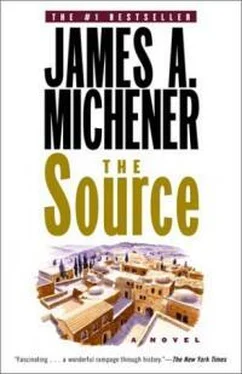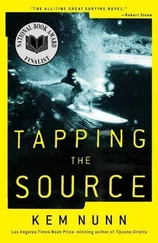Since it was essential that his workmen see the range flags, Hoopoe ripped away the roof of the waterwall. He also demolished the circular wall around the well, and when the area was cleared he began sinking a narrow shaft straight down to water level. But when he approached the surface of the well he found an old cave that had been inhabited by men more than two hundred thousand years before. In the days when his forefather Ur had been worried about the cultivation of wheat, this earlier cave was already two thousand centuries old, buried and forgotten. Now Hoopoe walled it up again and continued his way down to the water level, and when he reached the desired spot he ordered his slaves to dig out a considerable hollow, providing a floor space from which his men could work and on which women seeking water in future years could rest their jars. Then across the upper opening of the shaft he placed a tree in line with the range of flags, and again he dropped two weighted lines to the well, and these showed the intended direction; but since the diameter of this temporary shaft was so much less than the diagonal of Meshab’s main shaft, the strings could not be far apart nor the accuracy of his range so precise, and the reason he had chosen to work from the well was because there the responsibility was greater. Eight and nine times a day he would lie on his stomach to check the range, satisfy himself that he must be headed right, then study the clay tablets to determine the upward pitch his slaves must follow. After that he had to trust that sooner or later his men digging on their upward slant would meet Meshab’s as they worked downward.
When these problems of direction and slant were solved there remained another of even greater difficulty. Hoopoe had always intended his water system to accommodate many women passing to and fro with jugs on their heads, and this required the tunnel to be about ten feet high and six feet across, and no matter how skillfully Meshab dug downward from the shaft and Hoopoe upward from the well, if they dug massive full-sized tunnels it would be a miracle if they met exactly. “I’d never find you down there,” Hoopoe confessed. “You might be digging on that level, I on this, and we’d go right past one another. We’d waste years.”
Meshab agreed: “If we did happen to meet it would be pure luck.”
“But what we can do,” Hoopoe reasoned, “is to start with very small holes. Just big enough for the diggers to work in. We’ll penetrate until we can hear each other through the rock. Then we’ll join the small holes. Yours may be above mine or off to one side, but that won’t matter. Because we can go back and dig our tunnels the proper size, making whatever corrections are necessary.” Meshab had agreed to the plan, and now in the month of Abib, at the beginning of the third year, when in the fields above the spring rain came down and brewers sought the new barley, the two men drove at each other through little tunnels barely four feet high and only two feet wide. For hours at a time a skilled slave would work in cramped position, hardly able to swing his hammer. When he had finished chopping away the rock, other slaves would crawl in to pass along the debris until it reached the well, and then a fresh cutter would move to the face of the rock; twenty-four hours a day the work continued, since the presence of daylight was of no consequence. But each evening, when sunset colored the town a shimmering bronze, came the most exciting moment of the excavation. The slaves would withdraw from their little tunnels and Meshab the Moabite would descend the main shaft and crawl with a sledge to the end of his tunnel, while Hoopoe would climb down into the well and lug his sledge to the face of his. On the town wall between the two entrances a slave would stand holding a long pole bearing a white flag. When other slaves at the two openings signaled that the men with the sledges were in place, the slave on the wall would wave his flag ceremoniously, then dip it sharply toward, the town. Slaves stationed in the main shaft would shout down the echoing deep, “Meshab, Meshab! It is your turn.” At the entrance to the downward tunnel other slaves would cry, “Meshab, Meshab! It is your turn.” And at the face of his tunnel Meshab the Moabite would hammer the solid rock nine times in slow, steady rhythm, hoping that somewhere in the earth his partner Hoopoe might hear.
At the end of the ninth blow Meshab would call back that he had finished, and the signal would pass to the shaft and up to the slave on the wall. With a flourish he would drop his flag toward the well outside the walls, and there other slaves would echo, “Hoopoe, Hoopoe! It is your turn,” and in the darkness of his tunnel the master engineer would strike his wall nine times in stately rhythm while Meshab listened; but always the mass of rock between the two men absorbed the sound.
Each dusk the men sent nine signals nine times, then crawled out of their holes and met to discuss what was happening. Since they could measure with cords how far each had penetrated into the earth, and since they could lay off those measurements along the line of the water-wall, they could see from the ground approximately where the ends of the tunnels must be, and as night came they would stand on the surface where the cords lay and deduce how far apart they were.
They were now separated by some sixty feet and were reaching the point at which it ought to be possible for sounds to be carried through limestone, and they began to hope that at the next sunset they would hear each other, but even when they didn’t they felt a growing sense of assurance that they must be on the right headings. Their work was an act of faith so intense that of itself it had sustained them during the first two years, and they went each morning to the tunnels refreshed. Perhaps this would be the day when the first sound would be heard. But when the month of Abib passed and Ziv came again, when men coming out of the dark tunnels looked with whatever joy slaves can know at the new flowers, the two leaders began to lose courage because of the failure of their signals to penetrate the rock. Could something be wrong? Could they be so wide of each other, or so ill placed vertically, that they were missing by a large margin?
Patiently they reconstructed the operation, confronting each possible source of error honestly like men well trained. “You go to the mountain this time,” Hoopoe suggested, “and check the range I laid out.” The Moabite left the town while Hoopoe climbed the walls and the various houses, making signals with a flag, and Meshab satisfied himself that all was in order. He came back to report, “The range is right.” They then checked to see if the poles across the two openings conformed to the range, and they did. Next came the critical part of the work. Did the lines dropping down into the holes accurately reproduce the range established above? At the main shaft this was relatively easy to check, for the diagonal was adequate, permitting the two cords to stand relatively far apart, and this insured a secure heading. “This end has got to be right,” Hoopoe said, but when they went to the well, where the opening was small and where the critical cords could not be far apart, it was apparent that error might have crept in.
With the greatest care the two men checked and rechecked the orientation at the well and they had to conclude that it was impossible to be sure. “It could be a little more to the north,” Meshab said honestly, and even a small error at the beginning would yield a tragic error when the length of the tunnel was so great. It was at this moment that Jabaal spoke like a true engineer. He was lying prone near the well while Meshab stood by the strings, and from this position he said, “This tunnel has got to be right. There can be no error and we must meet. But if we do not, it is because I have failed. My eye has erred and the fault is on me.”
Читать дальше








![Джеймс Купер - Пионеры, или У истоков Саскуиханны [The Pioneers, or The sources of the Susquehannah]](/books/395797/dzhejms-kuper-pionery-ili-u-istokov-saskuihanny-t-thumb.webp)

